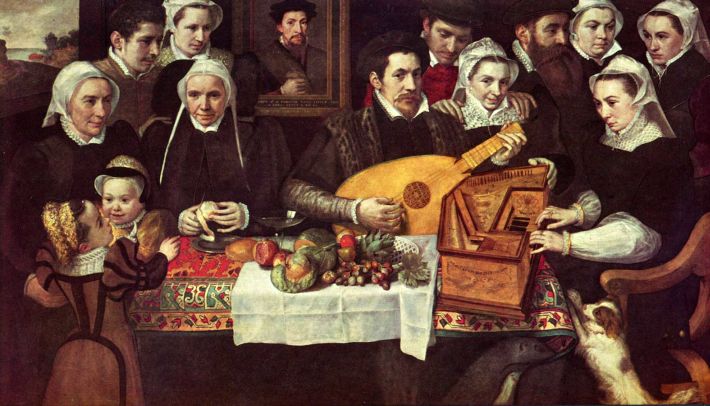Musical Instruments
The Ximenez inventory lists five musical instruments: "a lute with a case" (een luyt met custodie), "another large lute with a case" (een ander groote luyte met custodie) and "a guitar" (een guiterne) next to the porcelain room, "a harpsichord made by Ruckert, painted by Hendrik van Balen and [Jan I] Brueghel with scenes of Poetry, on a hardwood base" (eene clavecimbele steertstuck van Ruckert, beschildert by Henric van Balen ende Bruegel met Poëterye op een herthouten voet) in the large sitting room, and "a harpsichord/virginal" (een clavercimbele) in the dining room.
The "luyt" or lute is a wooden string instrument that was popular throughout Europe from the Middle Ages to the eighteenth century. The instrument has a vaulted back assembled from bent ribs, a large neck, and a pegbox at nearly a right angle to the neck, with tuning-pegs inserted laterally. Lute cases were specially adapted to the form of the instrument. The "guiterne" or guitar, at the beginning of the seventeenth century, was a smaller instrument than the lute, sometimes heavily decorated and mostly used for a lighter repertoire. In the Low Countries, the guitar certainly was less widely used than the lute, but its presence in the Ximenez household is easily explained, as guitar-shaped instruments were popular in the Iberian Peninsula.
In the seventeenth century, the Dutch word 'klavecimbel,' or harpsichord, had a more general meaning than it does today. It referred to a plucked string instrument with a keyboard, including both the harpsichord and the virginal, and in the early modern period such keyboard instruments were typically used by women. From the inventory, it can be assumed that Isabel da Vega had two keyboard instruments: in the sitting room, certainly a harpsichord, the word "steerstuck" or "staarstuck" (tailpiece) being used to distinguish the harpsichord from the virginal which was called "vierkant" (rectangular). But it is impossible to discern if the instrument in the dining room, termed only as a "clavercimbele" in the inventory, was a harpsichord or a virginal. Also in contrast to the instrument in the dining room, the maker of the harpsichord in the sitting room is named: "Ruckert" or Ruckers, who was at that time the most prestigious name in harpsichord production. In addition, Isabel da Vega's harpsichord was not an ordinary Ruckers instrument but a luxurious one, with paintings by great masters. It was therefore the best that money could buy, and the quality of its craftsmanship would have been apparent to those who saw and heard it.
The Ximenez family's possession of musical instruments seems typical for families of their social status in Antwerp. Lutes and harpsichords were present in many wealthy families and were regularly represented in family portraits of the sixteenth and seventeenth centuries. The harpsichord, furthermore, was a symbol of distinction and sophistication. It was the instrument of the aristocracy, perfectly adapted to the interpretation of subtle Baroque music.
Literature
Kümmerling, Harald. Paradisus musicus: Muziek en samenleving in Rubens' tijd. Antwerp: Rubenshuis, 1977.

Frans Floris, The Van Berchem Family, c. 1561, Wuyts-Van Campen and Baron Caroly Museum, Lier. Image: © Wuyts-Van Campen and Baron Caroly Museum.


